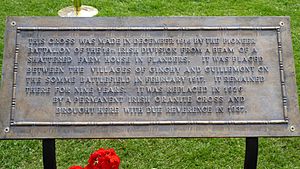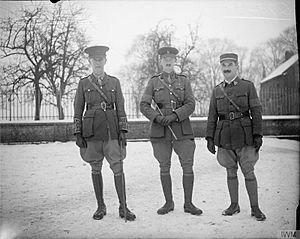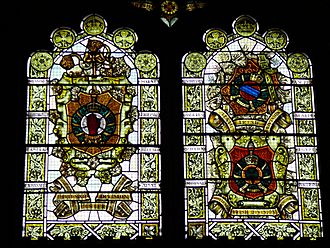16th (Irish) Division facts for kids
Quick facts for kids 16th (Irish) Division |
|
|---|---|
 |
|
| Active | 1914 – 1919 |
| Country | |
| Branch | |
| Type | Infantry |
| Size | Division |
| Engagements | |
| Commanders | |
| Notable commanders |
Major-General William Hickie |
The 16th (Irish) Division was a group of soldiers, called an infantry division, that was part of the British Army. It was formed for service during World War I, also known as the Great War. This division was made up of volunteers who joined Lord Kitchener's new army, called 'New Armies'. It started in Ireland in September 1914, soon after the war began. Many of its first members came from a group called the 'National Volunteers'.
In December 1915, the division moved to France. There, it joined the British Expeditionary Force (BEF), which was the main British army fighting in Europe. The 16th (Irish) Division was led by an Irish general named Major General William Hickie. They spent the rest of the war fighting on the Western Front, which was a long line of trenches across France and Belgium. After suffering huge losses in major battles like the Somme, Passchendaele, and Ypres, the division had to return to England for new soldiers and training between June and August 1918. Many of the new soldiers were not Irish.
Contents
How the Division Started and Trained
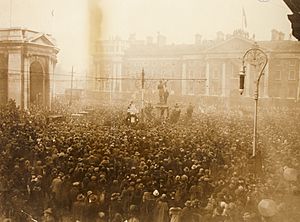
When World War I began, many people in Ireland felt sad about what was happening in Belgium, a small country. John Redmond, a political leader, asked Irishmen to join the army to defend what he called "the highest principles of religion and morality and right." More Catholic Irish people joined the army than Protestants.
The 16th Division began to form in late 1914. At first, Irish recruits from England and Belfast joined the 10th (Irish) Division. Later, they were moved to the 16th Division. This new division was built around a group of soldiers from the National Volunteers.
Their first training happened in Ireland, in places like Fermoy and Buttevant. In September 1915, the division moved to Aldershot in Hampshire, England, for more intense training. After about three months, they were sent to Étaples in France. They became part of the British Expeditionary Force (BEF). At that time, the BEF was led by Field Marshal Sir John French, who was later replaced by General Sir Douglas Haig.
On December 18, the division moved to the front lines in the Loos area. They were commanded by Major General William Hickie. The 16th (Irish) Division remained on the Western Front for the rest of the war.
Fighting on the Western Front
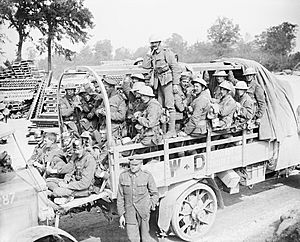
In January and February 1916, the 16th Division experienced trench warfare for the first time near Loos. They suffered many casualties in the Battle of Hulluch. Throughout May and June, their soldiers carried out raids on German trenches.
In late July, the division moved to the Somme Valley. Here, they were heavily involved in the Battle of the Somme. The 16th Division played a key role in capturing the towns of Guillemont and Ginchy. However, they suffered huge losses. Between September 1 and 10, 1916, they lost 224 officers and 4,090 men. Despite these very heavy losses, the division became known as excellent "shock troops," meaning they were very effective in attacking enemy lines.
In early 1917, the division took a major part in the Battle of Messines. They fought alongside the 36th (Ulster) Division, which helped both divisions gain more recognition and a strong reputation. Their main actions in 1917 ended in the summer at the Battle of Passchendaele. During this battle, also known as the Third Battle of Ypres, both divisions were very tired. They had spent 13 days moving heavy equipment under constant shelling. Despite this, they were ordered to advance through deep mud towards strong German positions. By mid-August, the 16th Division had lost over 4,200 soldiers, and the 36th Division had lost almost 3,600. This meant more than half of their soldiers were gone.
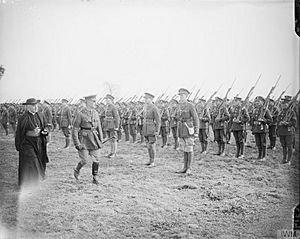
In early 1918, the 16th Division was in an exposed position near Ronssoy. They suffered even more heavy losses during the German Army's Spring Offensive in March. The division was almost completely destroyed in the retreat that followed a German attack called Operation Michael. The division had the highest number of casualties of any British division at this time. Records from German divisions show that the Irish soldiers fought bravely.
After these heavy losses, the remaining parts of the division were moved to another army group. The 16th Division helped to finally stop the German attack before the Battle of Hamel. After this, the decision was made to break up the division. The few remaining original battalions were sent to other military groups.
On June 14, the division returned to England to be rebuilt. Because of a situation in Ireland called the Conscription Crisis of 1918, fewer Irish recruits could be found. So, when the 16th Division returned to France on July 27, it included five English battalions, two Scottish battalions, and one Welsh battalion. The only original Irish battalion left was the 5th Royal Irish Fusiliers.
Order of Battle: What Made Up the Division
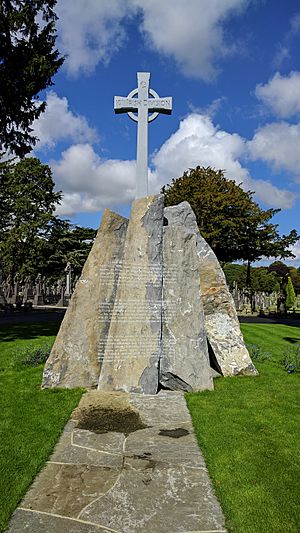
The "Order of Battle" lists the different units that made up the 16th (Irish) Division during World War I. A division is usually made up of several brigades, and each brigade has several battalions.
47th Brigade
This brigade was often called the "Nationalist Brigade" because most of its soldiers came from John Redmond's Irish Volunteers.
- 8th (Service) Battalion, Royal Munster Fusiliers (New Army) (disbanded November 1916)
- 6th (Service) Battalion, Royal Irish Regiment (disbanded February 1918)
- 7th (Service) Battalion, Prince of Wales's Leinster Regiment (Royal Canadians) (disbanded July 1922)
- 6th (Service) Battalion, Connaught Rangers (left June 1918)
- Other battalions joined and left over time, including units from the Welsh Regiment, Leicestershire Regiment, and Black Watch.
- It also had a Machine Gun Company and a Trench Mortar Battery.
48th Brigade
- 9th (Service) Battalion, Royal Munster Fusiliers (New Army) (disbanded May 1916)
- 7th (Service) Battalion, Royal Irish Rifles (left August 1917)
- 8th (Service) Battalion, Royal Dublin Fusiliers (merged with 9th Battalion in October 1917)
- Other battalions joined and left, including units from the Royal Dublin Fusiliers, Royal Munster Fusiliers, Northumberland Fusiliers, Royal Irish Fusiliers, and Cameronians (Scottish Rifles).
- It also had a Machine Gun Company and a Trench Mortar Battery.
49th Brigade
- 7th (Service) Battalion, Royal Irish Fusiliers (merged with 8th Battalion in October 1916)
- 7th (Service) Battalion, Royal Inniskilling Fusiliers (merged with 8th Battalion in August 1917)
- Other battalions joined and left, including units from the Royal Irish Regiment, London Regiment, Gloucestershire Regiment, and Somerset Light Infantry.
- It also had a Machine Gun Company and a Trench Mortar Battery.
Other Divisional Troops
The division also included other important units that supported the fighting brigades:
- Pioneer Battalion: 11th (Service) Battalion, Hampshire Regiment (joined September 1914)
- Machine Gun Battalions: These units provided heavy firepower.
- Divisional Mounted Troops: Such as the Army Cyclist Corps and a squadron from the South Irish Horse.
- Divisional Train: The Army Service Corps units that handled supplies and transport.
- Medical Units: Royal Army Medical Corps field ambulances for treating wounded soldiers.
- Engineers: Royal Engineers field companies for building trenches, bridges, and other structures.
- Artillery: Royal Artillery brigades with various types of guns and trench mortars.
Leaders of the Division
The following officers were in command of the 16th (Irish) Division at different times:
| Appointed | General officer commanding |
|---|---|
| 1914 | Major-General Lawrence Parsons |
| December 1915 | Major-General William Hickie |
| February 1918 | Major-General Archibald Ritchie |
See also
- List of British divisions in World War I
- 10th (Irish) Division
- 36th (Ulster) Division
Great War Memorials
- Irish National War Memorial Gardens, Dublin.
- Island of Ireland Peace Park Messines, Belgium.
- Ulster Tower Memorial Thiepval, France.
- Menin Gate Memorial Ypres, Belgium.


